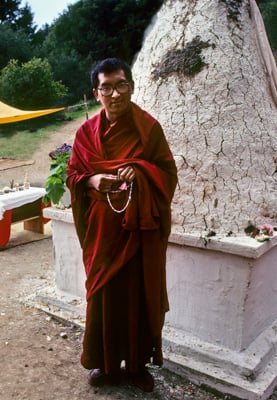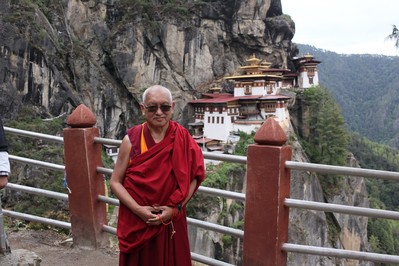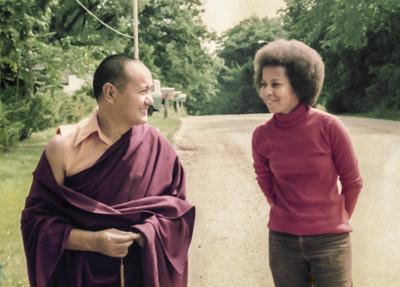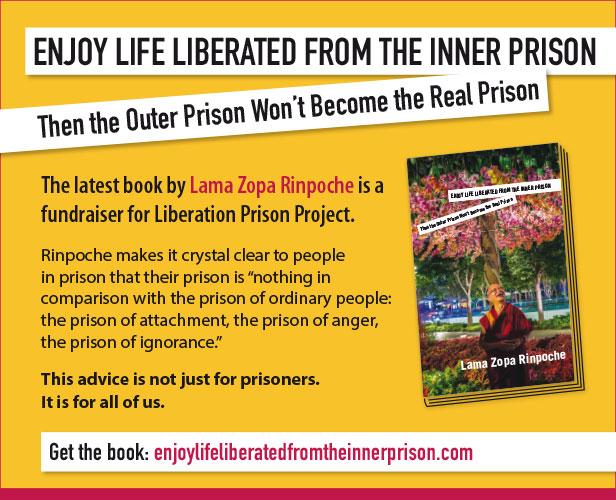Dear Friends,
This year, the fifteenth day, the Day of Miracles, falls on February 27. As cited by Lama Zopa Rinpoche from the Vinaya text Treasure of Quotations and Logic, the karmic power of all actions done on the anniversary of these events is multiplied by one hundred million. You can find Rinpoche's advice on practices for merit multiplying days here.
PLEASE SUPPORT LYWA AT THIS AUSPICIOUS TIME
From the Video Archive: Patience on the path to overcome desire
On the LYWA Podcast: A meditation on emptiness
 Delusion and karma come from the mind; they don’t come from outside. The main cause is the mind, so we need to learn more about our own mind, about delusion and karma, and about the path.
Delusion and karma come from the mind; they don’t come from outside. The main cause is the mind, so we need to learn more about our own mind, about delusion and karma, and about the path.—Lama Zopa Rinpoche
WHAT'S NEW ON OUR WEBSITE
 This month we have also posted two new chapters from Teachings at the Kadampa Deities Retreat, held at Institut Vajra Yogini, France, in 2003. In Lecture 10, Rinpoche discusses refuge and bodhicitta, and in Lecture 11, Rinpoche tells students about the great bodhisattva Khunu Lama Rinpoche, gives a detailed explanation of Shakyamuni Buddha's holy name and mantra, and advises the karma of harming others.
This month we have also posted two new chapters from Teachings at the Kadampa Deities Retreat, held at Institut Vajra Yogini, France, in 2003. In Lecture 10, Rinpoche discusses refuge and bodhicitta, and in Lecture 11, Rinpoche tells students about the great bodhisattva Khunu Lama Rinpoche, gives a detailed explanation of Shakyamuni Buddha's holy name and mantra, and advises the karma of harming others.
This month in our featured short video from FPMT's Essential Extracts series, Lama Zopa Rinpoche explains how to show respect to Dharma texts, including digital devices containing Dharma. You can find links to the video here, or visit FPMT’s Essential Extracts webpage to browse the entire collection.
As always, we have new additions to Lama Zopa Rinpoche's Online Advice Book to share with you:
- Meditations to Subdue Attachment: A student had developed strong attachment to a monk. Rinpoche advised meditating on impermanence, the impurity of the body, the sufferings of samsara, and the emptiness of the object of attachment.
- Essential Practices for a Busy Student: A student wrote requesting practice advice. Rinpoche suggested several daily practices and recommended training the mind in the graduated path (lamrim) until enlightenment is achieved.
- It’s Better to Be a Monk: A monk wrote that he wanted to disrobe. Rinpoche told him that real happiness comes from renouncing the eight worldly concerns and attachment to this life.
- Pilgrimage to Bhutan: In this letter, Rinpoche described his experience of Bhutan while on pilgrimage there in 2016.
Big Love Festival
 Professor Jan Willis, one of Lama Yeshe’s very earliest students and who is featured in Big Love, shared deeply personal and inspiring stories about Lama during the Big Love Festival hosted by the Foundation for Developing Compassion and Wisdom in late November 2020. You can watch her talk on YouTube here.
Professor Jan Willis, one of Lama Yeshe’s very earliest students and who is featured in Big Love, shared deeply personal and inspiring stories about Lama during the Big Love Festival hosted by the Foundation for Developing Compassion and Wisdom in late November 2020. You can watch her talk on YouTube here.ENJOY LIFE LIBERATED FROM THE INNER PRISON
 In case you missed it, our latest book from Lama Zopa Rinpoche is now published. Enjoy Life Liberated from the Inner Prison: Then the Outer Prison Won't Become the Real Prison is a compilation of more than 100 letters Lama Zopa Rinpoche has written to prison inmates over the years. But this book of advice goes beyond those in prison. It is advice for all of us in samsara. Compiled and edited by Ven. Robina Courtin, this book has been published as a fundraiser for Liberation Prison Project. You can read an excerpt in this month's eletter teaching below. Visit here to obtain your copy and to make a donation to LPP and thereby help bring more Dharma to prisoners.
In case you missed it, our latest book from Lama Zopa Rinpoche is now published. Enjoy Life Liberated from the Inner Prison: Then the Outer Prison Won't Become the Real Prison is a compilation of more than 100 letters Lama Zopa Rinpoche has written to prison inmates over the years. But this book of advice goes beyond those in prison. It is advice for all of us in samsara. Compiled and edited by Ven. Robina Courtin, this book has been published as a fundraiser for Liberation Prison Project. You can read an excerpt in this month's eletter teaching below. Visit here to obtain your copy and to make a donation to LPP and thereby help bring more Dharma to prisoners. YOUR CHOTRUL DUCHEN OFFERING
Please remember LYWA when making your contribution on this special day to help us make more of Lama Yeshe’s and Lama Zopa Rinpoche’s teachings available throughout the entire world.
Thank you so much for your kindness,
Big love,

Nick Ribush
Director
THIS MONTH'S TEACHING: WE ALL HAVE MANY LIFETIMES
 This body disintegrating and dying doesn’t mean that the mind, the consciousness, ceases; it continues and takes another life, based on our karma.
This body disintegrating and dying doesn’t mean that the mind, the consciousness, ceases; it continues and takes another life, based on our karma.My name is Lawudo Lama. I bear the name of an incarnate lama. I guess this is from some merit, positive actions, done in past lives. I was born in the Himalayan mountains, in Solu Khumbu, near Mount Everest. Hopefully, one day you can visit there; it is a totally different world.
On one side of Mount Everest is Nepal and on the other side is Tibet. Since ancient times, many holy beings, great yogis, have achieved high attainments in caves in these mountains, as I mentioned before. They have meditated and achieved liberation there.
I try to help a little bit in the world, teaching meditation on the nature of phenomena. I also emphasize ethics, teaching about cause and effect, showing which causes bring which effects: from positive causes comes happiness and from negative causes comes suffering.
I also teach compassion, the wish to alleviate the suffering of living beings and to bring them ultimate, everlasting, peerless full enlightenment. Driven by this compassion, having achieved this completely liberated state ourselves, in which all the mistakes of mind, gross and subtle, have been eliminated and a complete understanding of reality has been realized, we are now able to do perfect work for all the countless living beings and to lead them, in turn, to their perfect, peerless bliss and full enlightenment.
Reincarnation and remembering past lives
We have a body and a mind, and we relate to them as the self, the “I,” which is merely imputed. This body disintegrating and dying doesn’t mean that the mind, the consciousness, ceases; it continues and takes another life, based on our karma. Today’s mind began at dawn, but it is the continuation of yesterday’s mind, just before dawn. So, like that, this year’s mind is the continuation of last year’s mind; it’s not the mind of a separate being. That is why we are able to remember what we did yesterday, where we went, the food we ate, the people we met, and so forth. The child we were and the person we are today are not separate, they are the same. Again, this is why you can remember what you did as a child.
It’s similar with past lives. Even though most people don’t remember, our mind is a continuation of the mind before we were born. Your mind did not begin only after your body came out of your mother’s womb, nor when your consciousness entered the fertilized egg, which is when the association of body and mind started.
Even though most people don’t remember being in their mother’s womb and being born, there are many who do. I know someone who has a clear memory of it. These days there are many people, including children, who can even remember their past lives and describe them very clearly. This is not just the experience of Tibetan lamas; there are people in the West who are born with a memory of past lives. This shows that their mind is clearer, less polluted and obscured. Some people with this clarity of mind are able to see the future as well.
By cutting off attraction, scattering thoughts, and sinking thoughts in the concentration meditation technique called calm abiding, which has nine stages, the mind becomes clearer and clearer. Then we can develop higher powers. One can see things happening that other people cannot see, as well as being able to see things in distant places. Those who meditate on a deity also can develop this clairvoyance. One can achieve this even just by reciting mantras such as OM MANI PADME HUM. See chapter 17.
The great saints, the arya bodhisattvas who have achieved the first bhumi—one goes through ten bhumis to finally achieve full enlightenment—can remember hundreds of past lives and also can see the future. There is no question that as they reach higher bhumis, they discover and see a million times more past and future lives. This shows that there are past lives; this proves it. If there are past lives, then also there have to be future lives (see chapter 12).
My mother’s reincarnation
For example, after my mother passed away in the early 1990s, she was reborn as a boy to a family who lived close to where she had lived, in Lawudo. She lived there with my sister, and both became nuns. In Lawudo, there is a cave of the great eighth century enlightened yogi Padmasambhava, who placed his holy feet there for a short time. It’s also where I lived in retreat in my previous life as Lama Kunsang Yeshe, whose incarnation was predicted by many lamas.
From the time my mother’s incarnation was two years old, he was able to remember many things from his past life. He could recognize clearly all the family members of that life. He was not shy with them, as he was with other people; he immediately bonded with them. Also, he was able to recognize the animals that he used to care for. He could also remember many things that he had used when he was my mother and would look for them where she had left them.
My mother used to collect plastic buttons and keep them in a bottle. You see, when I was a child in Solu Khumbu in the 1940s and ’50s it was a very primitive area. The people regarded such things as spoons and plastic buttons, which we normally didn’t have, as very precious. When they got a shirt, even a torn one, they kept the plastic buttons as something very valuable. They’d even wear a spoon on a string around their necks, like people in the West wear necklaces. Also, there was no coffee, kerosene, gas or even candles. Now, Solu Khumbu has changed a lot and become modern.
When I was a child, rice was considered a very special food because it doesn’t grow there; people had to transport it for many days from faraway places. I remember that I would eat rice only on special occasions, like when a lama visited or when people came for the nyung nä fasting retreats (see chapter 17).
One year, on the first day of a retreat, my alphabet teacher and attendant, whom I was doing the retreat with, brought lunch that was leftover food of rice and curd. This was so special, a very happy occasion that happened once a year. Now rice has become a very common food; coffee, too.
When I was a child, the only light you had after dark was the fire you cooked on, or a piece of wood that had sap on it or dried bamboo that you could light up and put in the wall so that you could see your food or use when you went outside. Now there is electricity in many parts of Solu Khumbu, as well as gas lights.
Anyway, after my mother passed away, my sister sewed my mother’s buttons on her own shirt. My mother’s incarnation first came to Lawudo when he was about two years old. When my sister held him in her arms, the boy immediately pointed to the buttons and said, “They are my buttons!” He remembered them from his past life.
Also, in many respects his behavior was exactly the same as my mother’s. Whenever she went to Lawudo’s meditation room, she used to first circumambulate it seven times. Then, when she went inside, the first thing she did was prostrate to His Holiness the Dalai Lama’s throne and then take a blessing by touching her head to the throne. Then she would take a blessing from the small place where I would sit. Then she would take a blessing from the altar where there are buddha statues. When my mother’s incarnation first came there, he did exactly the same thing.
At the gathering of many local people where they first met my mother’s incarnation—monks, nuns, laypeople, including my brother Sangay, who lives in Kathmandu—everyone offered scarves, khatas, to him. This is a traditional gesture of respect and thanks that one shows to lamas, statues, scriptures and thangkas as well as an offering of good wishes and is a practice of collecting merit. After you offer the scarf to a lama, they give it back to you as a blessing by putting it around your neck.
My mother’s incarnation did this to each person who offered a scarf—except his own father of that life. You see, in his past life, when he was my mother in Lawudo, she had had problems with this man. The only water supply was a mile’s walk away. One time we manage to get lengths of pipe, which we connected to the water source that brought the water closer to Lawudo. The water source was near a hermitage and the family that lived there was not so happy about our pipe, so they blocked it with earth. My mother was very upset with them! The father of my mother’s incarnation was from that family. So, you see, the imprint from the boy’s past life as my mother of being very upset was still there, and he didn’t want to offer the scarf back to his present father!
Another story is about my mother’s close friend, Ang Puwa, who lived in Kathmandu. He came with my brother to the first meeting with my mother’s incarnation—who had no idea that Ang Puwa would be there. The parents of my mother’s incarnation served tea and chang, a kind of wine, to the guests. My mother’s incarnation saw Ang Puwa and immediately said, “Ang Puwa, please have some, please have some!” He grasped the child and cried because he could not believe the incarnation would remember him, even his name. He was speechless.
Everything comes from the mind
In the West, people don’t talk about imprints from past lives being the cause of why some children are angry and others have a more compassionate nature. You can see that in one family different children have different characteristics and different perceptions of the same object. Even from birth, we can see it’s like this. One child is born with more compassion and patience, and one child is born very impatient; one child naturally engages in harmful actions, another child naturally does not. So, the reason, the very clear logic for this is the past habits, which leave negative and positive imprints on the mind.
In Western culture, this is not part of our education; there is not much knowledge about the mind. But knowledge of the mind in the East is very developed, profound and vast. The omniscient one, Buddha—who is totally liberated from ignorance; liberated from all the errors of the mind, the defilements, the hallucinations; who is totally free from impure views and all the negative imprints; who is beyond all this, totally liberated—explained very clearly and extensively in his teachings about the nature of the mind, the function of the mind and all the different thoughts and mental factors.
Subjects such as how the world is created by the mind are not developed in Western culture. In Buddha’s psychology and philosophy, it is clearly explained how everything comes from karma, which is created by the mind. We have had beginningless lives, and any undesirable thing, or suffering, comes from negative imprints in the mind, and anything desirable, or happiness, comes from positive imprints in the mind.
Whatever is good comes from past positive habits and imprints, and whatever is bad comes from past negative habits and imprints. If you have the tendency to commit negative actions, or if you have them done to you, such as the ten nonvirtuous actions—killing, stealing, sexual misconduct, lying, slander, harsh speech, gossiping, covetousness, ill will and heresy—it is because you have done them in past lives. And it’s the same with virtuous actions. See chapter 15.
This is not only philosophy; it is a reality that you can see. Somebody who has clairvoyance can see what kind of past lives we had, what kind of practice we did.
REMEMBER
- Our mind is beginningless and endless.
- Therefore we have had countless past lives.
- What we do now determines our future lives.
- Negative actions ripen as suffering.
- Positive actions ripen as happiness.
- Everything comes from the mind.
Chapter 5 excerpted from Lama Zopa Rinpoche's latest book Enjoy Life Liberated from the Inner Prison: Then the Outer Prison Won't Become the Real Prison. Compiled and edited by Ven. Robina Courtin and published for Liberation Prison Project by LYWA. Purchase a copy of the book here and thereby help bring more Dharma to prisoners.





























